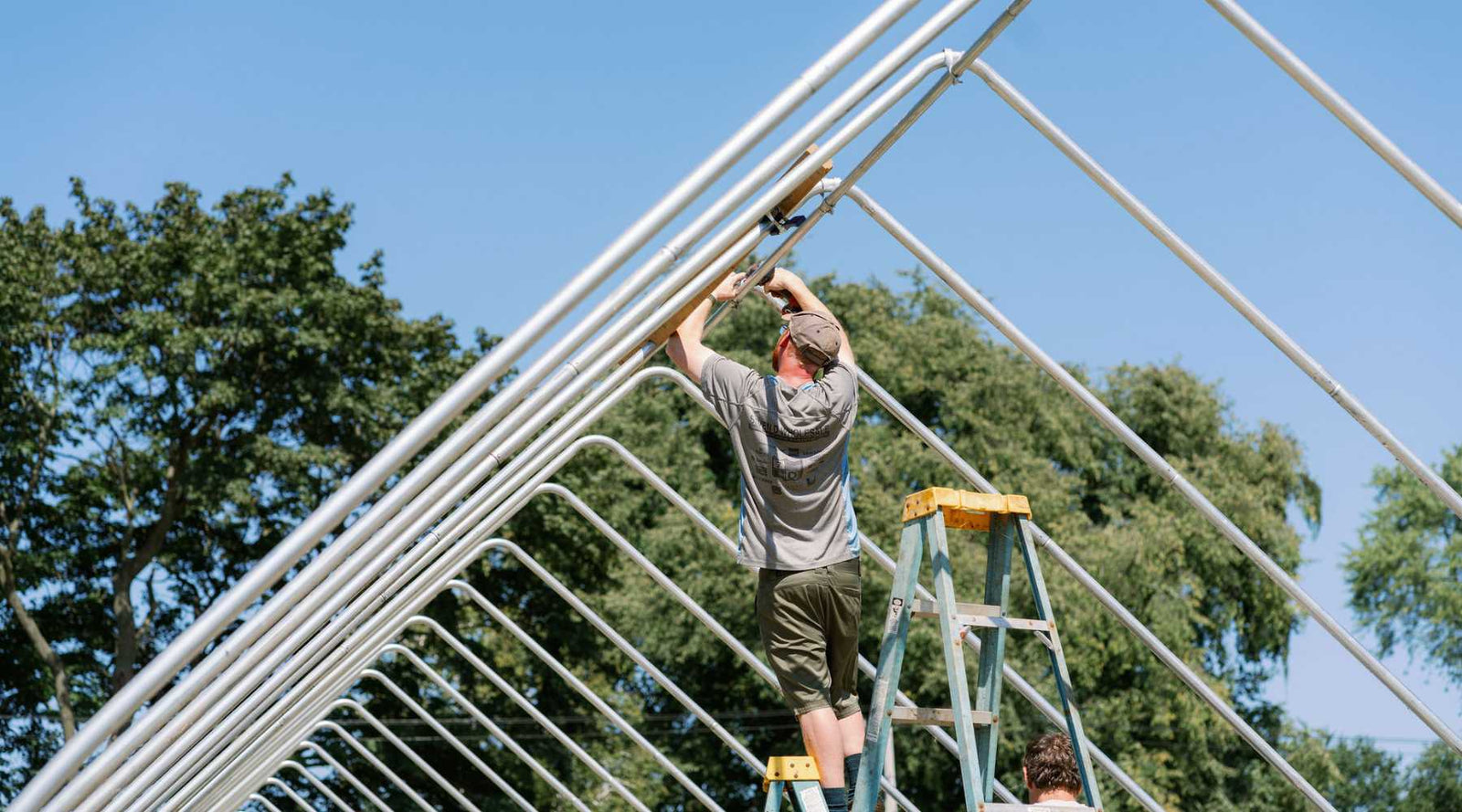Free Shipping on Orders over $75 to the Contiguous US
Free Shipping on Orders over $75 to the Contiguous US
Breaking Down the Cost of Greenhouse Installation
November 14, 2025 7 min read 0 Comments

What You Need to Know to Plan a Budget for Your Greenhouse Build
How much does it cost to install a greenhouse or high tunnel on your farm? The answer can vary widely depending on your location, but one truth holds: there will be costs beyond the price of your kit that you must budget for.
Knowing the potential hidden costs before you order a kit is essential for a successful build. No one wants to get halfway done and run out of funds. We are here to help you understand:
-
How size affects the cost of your build
-
Site preparation expenses
-
The cost of adding utilities
-
Foundation and flooring
-
Labor costs
-
Permits and regulations
-
What components you need upfront, vs. what you can add later
Let’s review what you need to know for a comprehensive budget for the best return on your investment.
Understanding Greenhouse Types and Their Price Points
Are you building a greenhouse or a high tunnel? Greenhouses are typically hard-sided structures with heating and cooling infrastructure. A hoop house or high tunnel is a less permanent structure with plastic film that relies on the sun for heating. If you need help deciding which is right for you, check out our article, High Tunnel Vs. Greenhouse.
While hard-sided greenhouses can be 700 times more effective at retaining heat, their overall cost reflects this. Hoop houses are most commonly used as an unheated season extender. In many areas of the country, this allows for year-round production.
To give you a jumping-off point on understanding costs, here are a few price ranges you can expect to see when buying a kit:
-
Small starter greenhouse (8x12)
-
Hard-sided polycarbonate greenhouse ranges from $2,000 to $15,500
-
High tunnel with 6 mil polyethylene film ranges from $500 to $5,000
-
Medium homestead greenhouse (12x24)
-
Hard-sided polycarbonate greenhouse ranges from $7,500 to $50,000
-
High tunnel with 6 mil polyethylene film ranges from $600 to $7,000
-
Large production greenhouse (20x48)
-
Hard-sided polycarbonate greenhouse ranges from $60,000 to $150,000+
-
High tunnel with 6 mil polyethylene film ranges from $6,500 to $20,000
Please note that these prices are exclusive to the base kits. Prices can vary significantly, depending on factors such as the gauge of the pipes and the features included. To compare kits before you buy, check out our article, "Are You Ready to Buy a Hoop House?"
How Does Size Affect the Cost of a Greenhouse Build?
While some costs are size-dependent, like the kit itself, many costs do not increase significantly as your build gets bigger. For example, equipment rental for a day stays the same no matter how big a space you grade. In addition, some costs per square foot will go down. Many gravel delivery companies charge less per ton when you order large quantities. Kit costs also go down with larger footprints. The end walls and doors are the most expensive part of any build, so longer kits cost less per square foot.
All of this often means that you can build a bigger hoop house without a lot of extra cost.

The Hidden Costs Most Sellers Don't Mention
Having a general idea of what extra costs you might incur during your build will help prevent costs from delaying your project.
Site Preparation Expenses
Hoop houses, greenhouses, and high tunnels should all be built on ground as level as possible. Regardless of the flooring option you choose, start with an even surface whose slope is less than 5° over a distance of 100 feet. Depending on the condition of the site when you start, leveling the ground with equipment will cost anywhere from $300 to $1,000.
If you have the necessary experience and ample working space, you can rent the equipment and complete the work yourself. If the site requires more work than you are capable of, consider inquiring about full-service options. Site preparation is much easier if you clear out any plants ahead of time. Learn about using silage tarp to kill vegetation beforehand here.
Bring in any necessary flooring and growing materials at this time, while the equipment is on-site. This prevents you from having to fit large equipment through high tunnel doors.
Bootstrap tip: Decide on your flooring early in the planning process. It will make the build smoother and less expensive.

Utilities and Drainage
Now is the time to think about power and water needs. If your site already has power, aren’t you lucky! Otherwise, run power for fans and ventilation, as well as automations like heat-controlled roll-up sides. In most locations, this necessitates digging a trench and hiring a qualified electrician.
PSA: Always call or log into 811 before you dig.
If you don’t have water nearby, thoughtfully place a hydrant nearby or run a heavy-duty hose from the nearest hose bib. Depending on your climate, you may need to run a water line below the frost line and install a frost-free hydrant. Connect your irrigation system with the proper fittings.
Proper drainage will save your crops from:
-
Excess irrigation water
-
Rainfall off the sides of the structure
-
Snowmelt from nearby slopes
We know from experience that without it, you’ll end up with flooded pathways, cold soil, and soggy roots. Consider a French drain. Dig a simple trench and install a perforated pipe and weed barrier, then cover them with small stones. This can divert thousands of gallons of water from the inside of your tunnel, ultimately protecting your crops.

Greenhouse Flooring and Foundation Options
There are many flooring options for your new hoop house or greenhouse. Always line new structures with high-quality landscape fabric of at least 5 oz. per square meter weight. This keeps weeds and grass away from the base, preventing damage commonly caused by weed whacking close to greenhouse plastic.
Here are the most popular flooring options we see:
-
Growing in-ground is the least expensive option. Budget for adding compost, landscape fabric, and mulch. In most areas, you can secure all of these for around $1 to $1.50 per square foot, assuming a depth of 6 inches.
-
Landscape Fabric is suitable for growing in containers or on tables. You can also use it between in-ground rows.
-
Concrete slabs are commonly used in propagation houses. Getting a slab poured will cost you around $10 per square foot for a small space and $7 per square foot for larger spaces.
-
Compacted rock is good for growing in containers. Installing and compacting the rock will run anywhere from $3 to $10 per square foot. The price will depend on the amount of rock required and the equipment needed to tamp it down. For example, a 20x40 space with 6 inches of gravel or stone would require 15 cubic yards or around 21 tons.
We do not recommend pea gravel, as it is difficult to walk on and maneuver wheelbarrows through.
Money Saver: Check local ads for free or cheap options on gravel, stone, and woodchip mulch that people can’t use or the landfill won’t take. Some municipalities offer free compost if you cover the delivery fee. Note that you can’t always be sure what you may get with free woodchips, such as weed seeds, pest eggs, or invasive plant roots.
Must-Have vs. Nice-to-Have Components
What you need will vary depending on your growing zone and climate. Some high tunnel features are must-haves, but we’ve also noted which are easy to add later.
Hoop House Structural Components |
|||
|---|---|---|---|
|
Element |
Must Have |
Nice to Have |
Can be Added Later |
|
No |
Yes |
Yes |
|
|
No |
Yes |
Yes |
|
|
No, but recommended in windy regions. *Wide and gothic styles may require. |
Yes |
Yes |
|
|
No |
Yes |
Yes |
|
|
No |
Yes |
Yes |
|
|
No *May be required on wider structures. |
Yes |
Yes |
|
Hoop House Climate Control Components |
|||
|---|---|---|---|
|
Component |
Must Have |
Nice to Have |
Can be Added Later |
|
No, but highly recommended *needed in Southern climates |
Yes |
Yes |
|
|
No *necessary if you need to be gone during the day. |
Yes |
Yes |
|
|
No, but highly recommended |
Yes |
Yes |
|
|
No |
Yes |
Yes |
|
|
No |
Yes |
Yes |
|
|
No, but highly recommended |
Yes |
Yes |
|
|
No |
Yes |
Yes |
|
|
Greenhouse Heater |
No |
Yes |
Yes |
|
No *needed in Southern climates |
Yes |
Yes |
|
|
Evaporative Cooling/Wet Wall |
No |
Yes |
Yes |
Real Cost Breakdown: Sample Budgets
Below you will find a few sample budgets using our planning worksheets. You can get your own copies of the worksheets here.

See the Cost Breakdown in Action
Get a closer look at what goes into greenhouse installation from framing and film to site prep and hardware. In this video, we walk through real numbers from an actual build and highlight where growers can save without cutting corners.
Return on Investment: Making Your Greenhouse Pay
Having a hoop house or greenhouse can help boost your production and income by extending the season. Discover how to maximize your hoop house's potential in "How to Make Money on Your Homestead."

FAQ Section
How long does greenhouse installation take?
Greenhouse installation can take as little as a weekend if your site is ready and you’ve got friends to help. Most of our customers do the work over a few weeks.
Can I build a greenhouse in stages?
Some steps of building a greenhouse can be done in stages. Plan out a timeline and do your best to stick to it. Check the forecast for rain so a storm doesn’t wash away all your site work!
What's the minimum budget needed to build a greenhouse?
You can build a small, simple greenhouse or hoop house for around $1,000 to $2,000. DIY options will keep costs down.
Do I need professional help for installation?
You may need a professional to help with ground leveling. You can build a greenhouse with some basic construction skills and the help of handy friends.
Do I need a permit to build a greenhouse?
Every municipality has its own set of rules, regulations, and fees associated with building codes. Check with yours before starting the process to avoid penalties.
Subscribe
Sign up to get the latest on sales, new releases and more …
